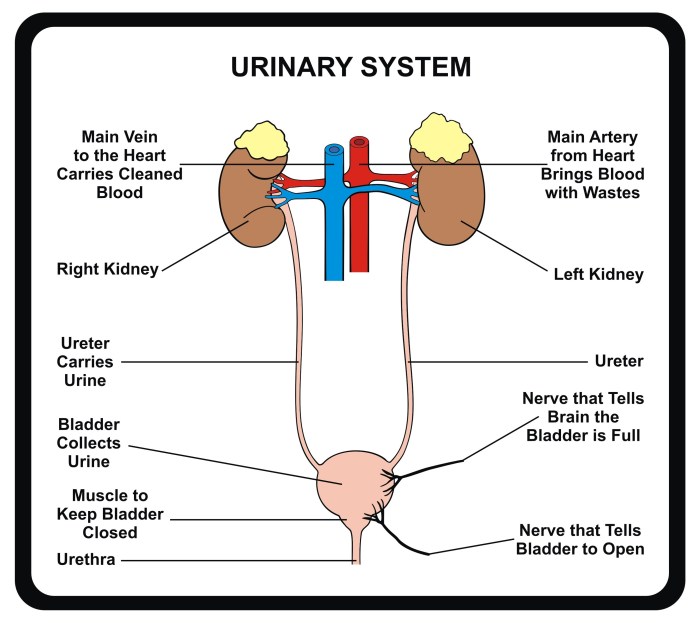Anatomy of the urinary system exercise 40 – Embark on a comprehensive exploration of the urinary system with Exercise 40: Anatomy of the Urinary System. This engaging journey unveils the intricate structure and vital functions of this essential bodily system, providing a foundation for understanding its role in maintaining overall health and well-being.
Delve into the intricacies of the kidneys, the ureters, and the bladder, gaining insights into their interconnected functions and the crucial role they play in filtering waste products, regulating fluid balance, and eliminating toxins from the body.
Anatomy of the Urinary System

The urinary system is responsible for eliminating waste products from the body. The kidneys, ureters, bladder, and urethra work together to filter waste from the blood, produce urine, and transport it out of the body.
Kidneys
The kidneys are two bean-shaped organs located on either side of the spine. They filter waste products from the blood and produce urine. The renal pelvis is a funnel-shaped structure that collects urine from the kidneys and directs it to the ureters.
Ureters
The ureters are two tubes that connect the kidneys to the bladder. They carry urine from the kidneys to the bladder.
Bladder
The bladder is a muscular organ that stores urine. When the bladder is full, it contracts and empties urine through the urethra.
Urethra
The urethra is a tube that carries urine from the bladder to the outside of the body.
Exercise 40: Urinary System Function

Urine Formation
Urine is formed in the kidneys through a process called glomerular filtration. Blood is filtered through the glomerulus, which is a network of tiny blood vessels in the kidneys. The filtrate, which contains waste products and excess water, is then processed by the renal tubules.
The tubules reabsorb essential nutrients and water back into the blood, while waste products are excreted into the urine.
Urine Transport
Urine is transported from the kidneys to the bladder through the ureters. The ureters are lined with smooth muscle, which contracts and relaxes to propel urine forward.
Urine Storage and Elimination
Urine is stored in the bladder until it is eliminated. When the bladder is full, it sends a signal to the brain, which triggers the urge to urinate. The bladder then contracts and empties urine through the urethra.
Clinical Applications

Urinary Tract Infections
Knowledge of urinary system anatomy helps in diagnosing urinary tract infections (UTIs). UTIs are caused by bacteria that enter the urinary tract through the urethra. The bacteria can travel up the ureters to the bladder and kidneys, causing infection.
Kidney Stones
Understanding urinary system function helps manage kidney stones. Kidney stones are hard deposits of minerals that can form in the kidneys. They can cause pain, bleeding, and infection.
Surgical Procedures
Urinary system anatomy is important in surgical procedures. Surgeons need to know the location and function of the urinary system organs in order to perform procedures such as kidney transplants and bladder repairs.
Comparative Anatomy
Urinary Systems of Humans and Other Mammals
The urinary systems of humans and other mammals are similar in structure and function. The kidneys, ureters, bladder, and urethra are all present in most mammals. However, there are some differences in the anatomy of the urinary system across species.
Similarities
- Kidneys filter waste products from the blood and produce urine.
- Ureters transport urine from the kidneys to the bladder.
- Bladder stores urine.
- Urethra carries urine out of the body.
Differences, Anatomy of the urinary system exercise 40
- The shape and size of the kidneys vary across species.
- The length and diameter of the ureters vary across species.
- The capacity of the bladder varies across species.
- The length and diameter of the urethra vary across species.
Evolutionary Adaptations
The urinary system has undergone evolutionary adaptations to meet the specific needs of different species. For example, the kidneys of desert animals are more efficient at conserving water than the kidneys of aquatic animals.
FAQ: Anatomy Of The Urinary System Exercise 40
What is the primary function of the renal pelvis?
The renal pelvis serves as a funnel-shaped cavity that collects urine from the kidneys and directs it towards the ureters.
How do the ureters contribute to urine transport?
The ureters are muscular tubes that propel urine from the kidneys to the bladder through peristaltic contractions.
What is the role of the bladder in the urinary system?
The bladder serves as a temporary storage reservoir for urine, expanding to accommodate increasing volumes and contracting to expel urine through the urethra.